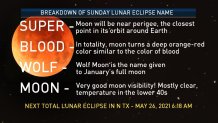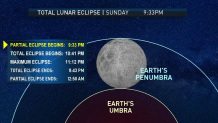On Sunday night, skywatchers in North Texas were treated to a Super Blood Wolf Moon under cold, but near-perfect viewing conditions.
What is a Super Wolf Blood Moon? Let's break it down.
We'll start off easy -- there are at least 12 full moons each year and they each have a name rooted in folklore that was often tied to seasonal markers. The Wolf Moon is simply the name given to the full moon in January.
A Super Moon is a full moon that coincides with perigee -- the moon's closest point to Earth in it's elliptical orbit. During a supermoon, the moon is roughly 50,000 kilometers closer and appears brighter and larger, even more so closer to the horizon.
What about the Blood Moon? A Blood Moon is the catchy name given to a total lunar eclipse due to the coppery-reddish hue seen at totality. A total lunar eclipse occurs when the sun, Earth and moon line up perfectly, causing a shadow to fall on the moon; sunlight scattered through the Earth's atmosphere causes the moon to appear a dull red.



[[504628111 , C]]

According to NASA, the eclipse was totally visible across the Americas. A slight haze was overhead on occasion, but otherwise there were clear, crips skies overhead making for near-perfect viewing conditions from beginning to end.
Local
The latest news from around North Texas.
If you're wanting to plan out your future eclipse viewing, NASA has calculated all lunar eclipses through the year 3000. However, if you'd just like to plan for this century, click here.
NASA said there will be only one other lunar eclipse in 2019, a partial eclipse on July 16 that will be largely visible over Africa and the Middle East. There will be four lunar eclipses in 2020, but they are all penumbral eclipses (only slightly visible).
[DFW] PHOTOS: Super Blue Blood Moon Over North Texas
According to NASA, the next total eclipse visible in the Americas will occur on May 16, 2022. The next Super Blood Moon wil occur on May 26, 2021 and will be will be partially visible to those in North Texas.
After that, The next Super Blood Moon will occur Oct. 8, 2033. It'll be a Hunter's Moon and also the fourth eclipse in the next tetrad (a rare grouping of four consecutive total lunar eclipses).



